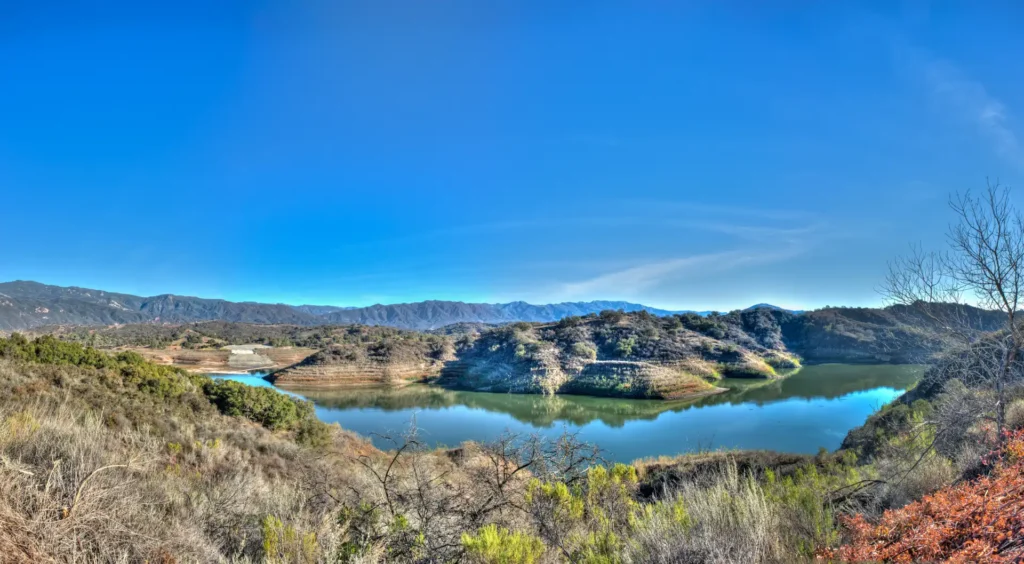California’s new water conservation policies, adopted in 2024, mark a significant milestone in the state’s efforts to address water scarcity. These regulations are crucial as California continues to battle the impacts of climate change and prolonged drought conditions. The statewide framework, known as “Making Conservation a California Way of Life,” aims to save 500,000 acre-feet of water annually by 2040.
The policies primarily target large urban water suppliers, which serve approximately 95% of Californians. This approach replaces previous one-size-fits-all mandates with tailored water budgets based on local factors such as climate, land use, and median income. By focusing on sustainable water management practices, California seeks to ensure long-term water availability for its residents and ecosystems.
Background of California’s Water Challenges
California has faced significant drought challenges throughout its history, with fluctuating periods of water scarcity. The state’s reliance on a limited number of water sources has often led to severe restrictions during dry spells. Historical data show that droughts in California can last for several years, causing widespread impact on agriculture, industry, and daily living.
Climate change makes these problems worse by changing rainfall patterns and increasing temperatures. This leads to less snowfall in the Sierra Nevada mountains, which is important for refilling reservoirs and rivers. Warmer climates also cause more evaporation, further reducing available water resources.
These ongoing challenges highlight the urgent need for sustainable water management. It is crucial to implement long-term conservation strategies in order to secure a dependable water supply for future generations. These strategies must tackle both immediate requirements and the anticipated effects of climate change on water availability.
Overview of the New Water Conservation Policies
 California’s new water conservation direction is built on the legislative foundation of AB 1668 and SB 606, two bills enacted in 2018. These laws set the stage for a thorough overhaul of how water is managed in the state, targeting efficiency and adaptability as climate patterns shift.
California’s new water conservation direction is built on the legislative foundation of AB 1668 and SB 606, two bills enacted in 2018. These laws set the stage for a thorough overhaul of how water is managed in the state, targeting efficiency and adaptability as climate patterns shift.
The regulations introduce a statewide water framework called “Making Conservation a California Way of Life.” Its core objective is to ensure long-term, reliable water supplies by requiring large urban suppliers to meet individualized conservation targets. The framework focuses on:
- Saving an estimated 500,000 acre-feet of water annually by 2040
- Establishing tailored water budgets for each supplier based on local conditions
- Promoting equity and affordability through targeted support for low-income households and struggling suppliers
The timeline sets January 1, 2025, as the effective date. Annual compliance tracking begins the same year, while mandatory reductions phase in from 2027 with some allowances for delays based on agency-specific circumstances. This structure places responsibility squarely on urban water suppliers to lead California’s sustainable water use into the next decades.
Key Features of the New Policies
California’s New Water Conservation Policies focus on a significant change in strategy. The state is moving away from blanket water restrictions and instead implementing customized water-use targets for each supplier. These tailored water budgets take into account important local factors and strive for practical, fair conservation efforts.
Here are the key elements:
- Tailored Water Budgets: Each urban water supplier receives a unique target based on specific regional conditions, not statewide averages.
- Urban Water Supplier Focus: The regulations apply to about 405 urban suppliers, covering communities where 95% of Californians live. This targeted enforcement means most residents will encounter these changes through their local utility rather than from state mandates.
- Influencing Factors: Individualized targets consider climate variability, land use patterns, median income levels, historical water use, and existing recycled water programs. Suppliers in hotter or drier regions, or those serving lower-income populations, receive targets reflecting those realities.
This flexible approach aims to make conservation more achievable and relevant across California’s highly diverse communities.
What Residents Need to Know About the New Policies’ Impact on Their Water Use
The impact of California’s new water conservation policies on residents centers on how the changes made by urban water suppliers will filter down to households. These regulations primarily hold the state’s largest urban water suppliers accountable for meeting conservation goals, not individual residents.
- Direct vs. Indirect Impact
The policies do not set enforcement or fines for individual homeowners. Instead, your urban water supplier is responsible for achieving specific, customized water-use targets based on local conditions. Suppliers serving about 95% of Californians must find ways to reach these goals.
- Changes in Water Allowances
Expect updates to both indoor and outdoor water allowances as suppliers adjust their systems to comply with the new framework. Indoor allocations may reflect efficient standards, while outdoor irrigation budgets could shrink—especially in regions facing hotter, drier conditions.
- Supplier Restrictions & Programs
Residents are likely to experience the policy shift through:
- Revised watering schedules or limits for lawns and gardens
- Incentive programs such as rebates for drought-tolerant landscaping or high-efficiency appliances
- Enhanced leak detection and repair initiatives
- Educational outreach about water-wise habits
Residents won’t see direct penalties from the state, but local supplier programs and restrictions will shape daily water use expectations. Suppliers may also prioritize equity by offering assistance or flexibility for low-income households as they roll out these changes. Adaptation at the household level will play a role in meeting community-wide goals set by each urban water supplier.
Compliance, Enforcement, Criticisms, and Future Vision of the New Policies
Annual Monitoring and Oversight
 Starting in 2025, California’s new water conservation framework will require all covered urban water suppliers to report their progress each year. This annual monitoring process tracks whether each supplier is meeting its unique water-use targets, which are based on factors such as climate, land use, and historical consumption. The data must be submitted to state regulators for review, allowing for a transparent assessment of compliance across the state.
Starting in 2025, California’s new water conservation framework will require all covered urban water suppliers to report their progress each year. This annual monitoring process tracks whether each supplier is meeting its unique water-use targets, which are based on factors such as climate, land use, and historical consumption. The data must be submitted to state regulators for review, allowing for a transparent assessment of compliance across the state.
Enforcement Fines and Penalties
Suppliers that fail to meet their individualized goals face significant financial consequences. State officials have established enforcement fines of up to $10,000 per day for non-compliance. These penalties are designed to provide a strong incentive for suppliers to meet conservation objectives and invest in efficiency measures. Repeated or egregious violations could lead to increased scrutiny and further regulatory action.
Criticisms and Stakeholder Concerns
The rollout of these policies has sparked criticism from multiple directions:
- Delayed Mandatory Reductions: Some environmental groups argue that the timeline allows too much flexibility. Many agencies will not be required to make significant cuts until 2027 or beyond, with a number of large suppliers granted extra leeway until as late as 2035.
- Perceived Leniency: Early versions of the regulations proposed more aggressive conservation targets and tighter deadlines. Opponents claim that the adopted framework is less stringent than necessary, given the urgency of California’s water challenges.
- Equity Considerations: While the new rules acknowledge affordability by assisting low-income households, some critics question whether gradual reductions will sufficiently address inequitable impacts from ongoing droughts.
State officials emphasize ongoing stakeholder engagement and policy revisions scheduled before 2028 as part of the long-term vision for sustainable water management. This vision is supported by comprehensive studies such as those found in this Stanford Law report, which provide valuable insights into effective policy implementation and enforcement strategies.
Practical Tips for Residents to Support Conservation Efforts
Residents can adopt several water-saving practices to support California’s new conservation policies:
- Fix Leaks Promptly: Even small leaks can waste significant amounts of water. Regularly check faucets, toilets, and irrigation systems.
- Install Water-Efficient Fixtures: Use low-flow showerheads and faucets, and consider replacing old toilets with high-efficiency models.
- Practice Smart Irrigation: Water the gardens early in the morning or late in the evening to reduce evaporation. Use drought-resistant plants that require less water.
- Collect Rainwater: Utilize rain barrels to collect and store rainwater for outdoor use.
- Reduce Indoor Water Use: Take shorter showers, turn off the tap while brushing your teeth, and run dishwashers and washing machines only with full loads.
Participating in local conservation programs is crucial. Urban suppliers often offer rebates for water-efficient appliances, free water audits, and educational resources on sustainable practices. Engaging with these initiatives not only helps conserve water but also fosters a community-wide effort towards sustainability.
By adopting these simple actions and leveraging local programs, residents can play a significant role in supporting California’s water conservation goals.
Conclusion
Securing the future of California’s water depends on shared commitment. California’s New Water Conservation Policies highlight that sustainable water management isn’t just a state mandate—it’s a community effort. Every household, business, and water supplier plays a role in protecting resources for generations ahead. When you participate in conservation programs or make conscious choices at home, you contribute to a resilient system that can withstand ongoing droughts and climate pressures. Collective action today shapes reliable water access tomorrow.

